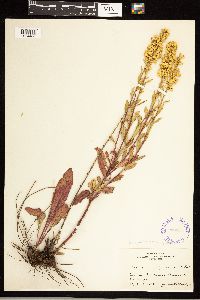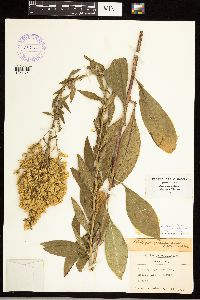Solidago speciosa
|
|
|
|
Family: Asteraceae
Showy Goldenrod, more...noble goldenrod, showy goldenrod
[Solidago speciosa subsp. speciosa, moreSolidago speciosa var. angustata Torr. & A. Gray, Solidago speciosa var. speciosa Nutt.] |
Plants (30-)50-200 cm; caudices stout, woody. Stems 1(-5), erect, glabrous proximally to strigillose in arrays. Leaves: basal and proximal cauline (sometimes withering by flowering) tapering to winged petioles, blades lanceolate to ovate-elliptic, 50-300 (including petiole) × 12-80 mm (sometimes firm), margins sharply serrate to crenate or entire, faces glabrate to sparsely strigillose; mid to distal cauline sessile, blades narrowly ovate to lanceolate or elliptic, 25-90 × 5-30 mm, gradually reduced distally, margins serrulate to entire (distally), ciliate , faces glabrous or sparsely scabroso-strigose. Heads 15-300+ , not secund, in usually dense, sometimes open, elongate, paniculiform to thyrsiform arrays, (5-)10-45 × (2-)3-7(-12) cm; branches strongly ascending, often racemiform. Peduncles 1.5-3 mm, sparsely to moderately scabroso-strigillose; bracteoles linear, grading into phyllaries, scattered along peduncles, clustered near heads. Involucres narrowly campanulate, 4-6.5 mm. Phyllaries in 3-4 series, appressed, strongly unequal, outer ovate, mid and inner lanceolate, (midnerves often raised and thick) apices acute to obtuse or rounded, glabrous. Ray florets (2-)3-7(-9); laminae 3-4 × 0.5-1 mm. Disc florets 6-16; corollas 2.5-4 mm, lobes 0.5-1.2 mm. Cypselae (narrowly obconic) 1.6-2.5 mm, glabrous; pappi 3-4.5 mm. Solidago speciosa occurs scattered throughout its range, often in small populations. Five races have been acknowledged; only three varieties appear to warrant recognition. The species is divided into two nearly allopatric subspecies. The typical subspecies includes two varieties that are sometimes difficult to distinguish and considerably overlap in their ranges. The differences in size and number of leaves and persistence of the proximal cauline leaves may be caused in part by growing conditions. Variety speciosa is the tall, robust, broad-leaved race of the species occurring throughout much of the range. Relatively few-leaved plants with more open paniculiform arrays from Illinois, Indiana, Michigan, Minnesota, and Wisconsin have been treated as var. jejunifolia; the status of that variety is uncertain and it may deserve recognition. Some specimens that have been assigned to var. jejunifolia are either typical S. uliginosa or possibly hybrids with that species. Narrower-leaved plants have been treated as var. angustata; the type material comes from eastern states, but the name has been misapplied to plants of var. rigidiuscula (with persistent narrow basal leaves) from the prairies and prairielike habitats along the western edge of the eastern deciduous forest in the United States (M. L. Fernald 1950).
Plants 3-15 dm from a stout, woody caudex, coarsely puberulent in the infl, otherwise glabrous or slightly scabrous; lvs thick and firm, entire or the lower slightly toothed, sometimes gradually increasing in size toward the base, the persistent lower ones then often broad and abruptly petiolate, to 30 נ10 cm, sometimes all smaller and nearly uniform, the lower then generally deciduous; infl not at all secund, usually dense, simple or more commonly with rather crowded, stiffly ascending branches, sometimes loose and more open, with conspicuously pedicellate heads; invol 3-5 mm, its bracts obtuse or rounded, glutinous, yellowish; rays 6-8, 3-5 mm; disk-fls 7-9; achenes glabrous, seldom over 2 mm; 2n=18, 36. Open woods, fields, prairies, and plains; Mass. and s. N.H. to Minn. and Wyo., s. to Ga., Ark., Tex., and N.M. Three vars. in our range: Gleason, Henry A. & Cronquist, Arthur J. 1991. Manual of vascular plants of northeastern United States and adjacent Canada. lxxv + 910 pp. ©The New York Botanical Garden. All rights reserved. Used by permission. From Flora of Indiana (1940) by Charles C. Deam Infrequent to frequent in the lake area and absent or local south of it. It grows only in sandy or gravelly soil and is found in open wooded dunes, open black and white oak woods, and in sandy prairies. …… Indiana Coefficient of Conservatism: C = 7 Wetland Indicator Status: N/A |
|
|
|































































































